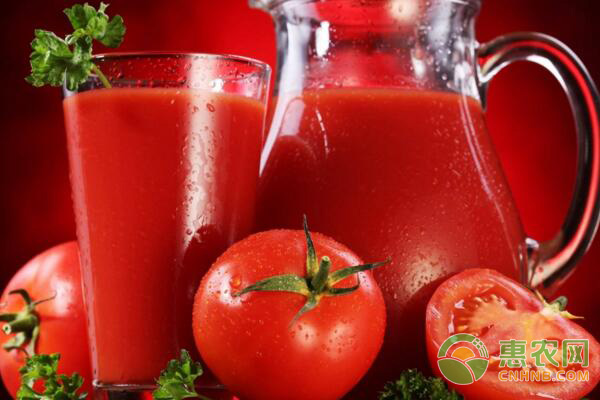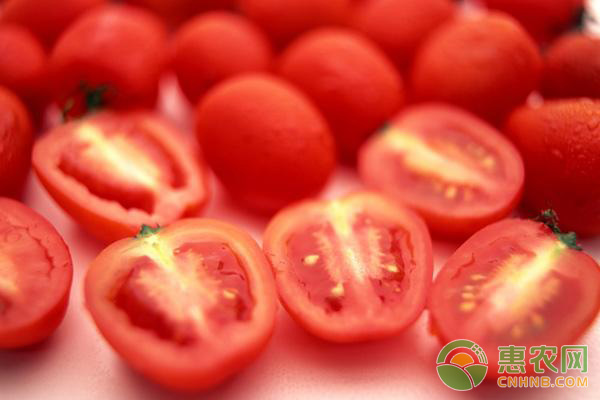Tomato juice is also called tomato juice. It has the unique color and natural flavor of tomato. It is rich in vitamins. It is a health drink with a large consumption in the world. In China, the current output is still small, and it has a trend of increasing year by year. Today, Xiaonong.com’s Xiaobian wants to share with you the process of tomato juice production. Interested friends can take a look. The quality standard of tomato juice is: it must be fully red ripe tomato juice. Except for a small amount of salt, it does not contain any additives, the color is bright red, the juice is uniform, and the pulp particles are evenly suspended in the original juice without precipitation and stratification. , all kinds of natural nutrients are well preserved, the lycopene content per 100 grams fresh weight is more than 7.5 mg, the soluble solid content is more than 5%, the total solid content is more than 7%, the ratio of sugar to acid is 9~12, pH value 4.2~4.3, the vitamin C content of each 100g fresh tomato is more than 12mg, the flavor is rich, no odor. The quality of tomato juice is affected by many factors such as the variety of raw materials, climate, soil conditions, cultivation techniques, harvest maturity and processing methods, and must be improved from all aspects to improve the quality of tomato juice. The color, aroma, taste and consistency of tomato juice mainly depend on the variety of raw materials. First, the process Raw material acceptance and storage, one cleaning, one selection, one crushing, one preheating, one juice, one exhaust, one heat sterilization, one canning, one sealing, one can sterilization. It is roughly the same as the ketchup processing process. Second, the operation points (1) Raw material selection Choose mature, non-invasive, fresh tomatoes, no pests and diseases, and rotten tomatoes. (2) Pretreatment Wash the tomatoes, remove the handles, remove the spots and green parts, use the machine to break the tomatoes, and immediately heat the tomatoes to more than 85 degrees Celsius with a heater. (3) Juice extraction Juice is extracted with a beater or a spiral juicer. The pulp is required to have no broken skin, black spots and impurities, and the juice rate is controlled to be about 80%. (4) deployment The tomato juice enters the mixing tank, and 0.5% to 1.0% of the salt is added (the salt is added to the solution and filtered and added). It is usually not necessary to add sucrose to the tomato juice. In a few countries, sucrose is allowed to be added to the tomato juice, allowing a maximum sugar addition of 1%. (5) Degassing and homogenization The degassing vacuum requires 0.05 MPa, 3 to 5 minutes, the homogenization temperature requires 70 degrees Celsius or more, and the pressure requires 18 MPa or more. (6) Filling and sealing The juice is heated to a temperature above 85 degrees Celsius and the center temperature at the time of sealing shall not be lower than 80 degrees Celsius. (7) sterilization, cooling Immediately after sealing, the cans are moved to a continuous rotary pressure sterilizer, heated at 121 degrees Celsius, maintained for 42 to 45 seconds, then sent to chlorinated water to rapidly cool to below 35 degrees Celsius, removed and dried, printed code, plus Posting trademarks, etc., and finally packing them into the warehouse. Sterilization can also be heated to 100 degrees Celsius and maintained for 5 to 10 minutes. Third, the quality standard Red or orange-red, the juice is turbid and even, there is no water precipitation and agglomeration. The color of the juice in the same tank should be the same, the smell and smell of fresh tomatoes, no odor. Fourth, the problem of precipitation of tomato juice Tomato juice has the following four precipitation phenomena. 1. There is mainly precipitation caused by finely divided pulp, and a small amount of sediment is observed under the microscope, and the flavor is usually normal. 2. After the canned food is stored in the warehouse for 5~7 days, the formation process begins with grayish white inclusions in the tomato juice, and then gradually settles to the bottom of the tank. After 3 weeks, the tomato juice becomes clear, the color is bright, and the precipitate gradually becomes grayish white powder. The shape gathers at the bottom of the tank and the taste quickly becomes sour. 3. A small amount of gray-white precipitate appeared after 1 to 2 months, or even longer, after production. The acidity did not change much. Under the microscope, many microorganisms were found in the precipitate. 4. The tomato juice produces a pale yellow precipitate, and gradually produces a taste like that processed with a non-fresh raw material. Under the microscope, various microorganisms, mainly various kinds of bacillus, are found in the precipitate. Bacterial sedimentation is mainly caused by high contamination rate of raw materials, unsatisfactory sanitary conditions during shutdown and intermittent production, mainly due to the presence of heat-resistant microorganisms in the finished product, which makes the chemical composition, appearance color and flavor of tomato juice Changes have occurred and are exacerbated by the appearance of off-white precipitates. The tomato juice is bright red and the taste is sour and not edible. The main measures to prevent bacterial precipitation are to strengthen the hygiene management in production, control the pH value of tomato juice below 4.3, and the high temperature instantaneous sterilization before canning. Sun Shade Netting,Shade Netting For Vegetables,Green Sun Shade Net,Green Net For Sun Protection Changzhou Satidi Import and Export Co., Ltd. , https://www.guanjiejts.com
